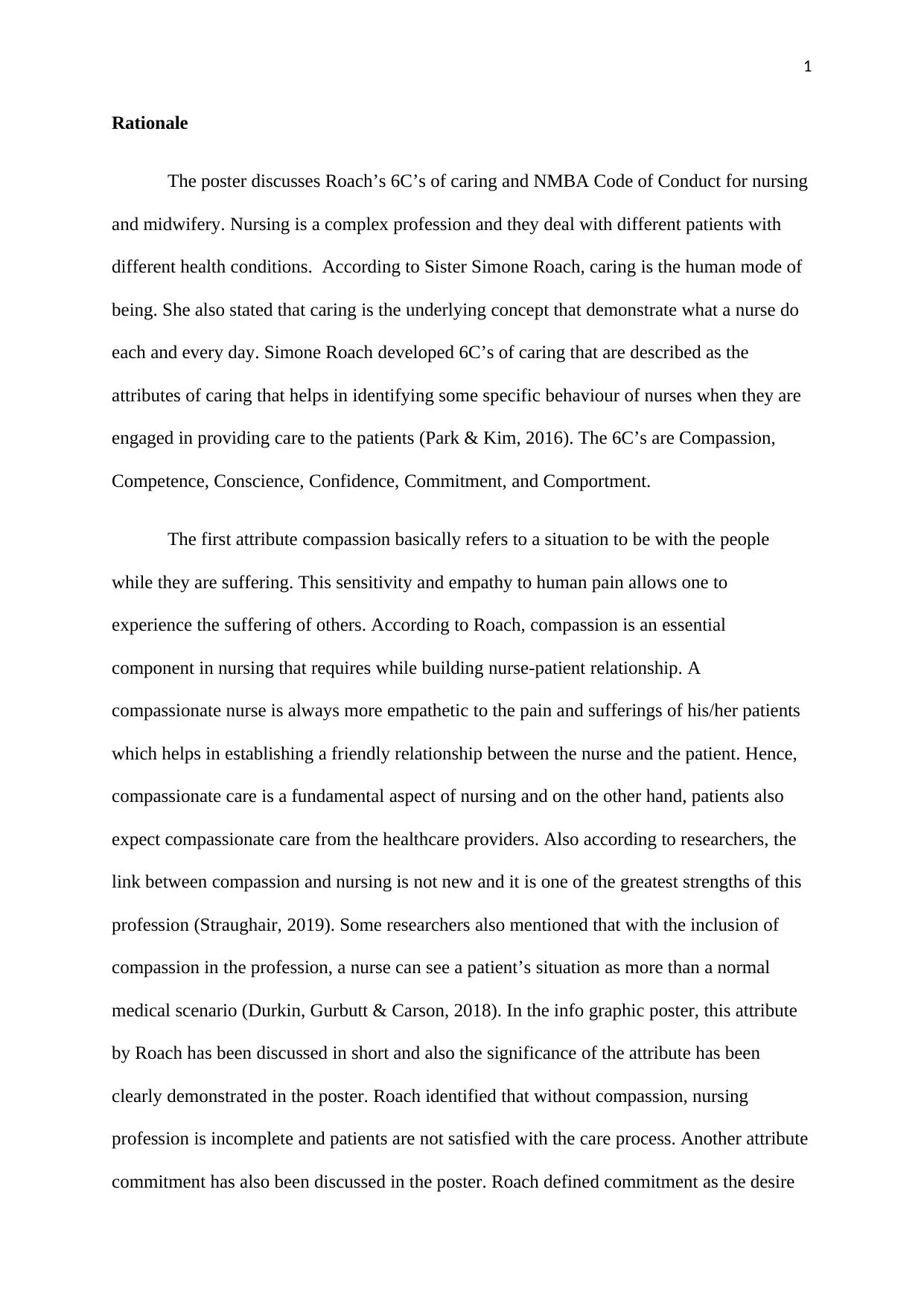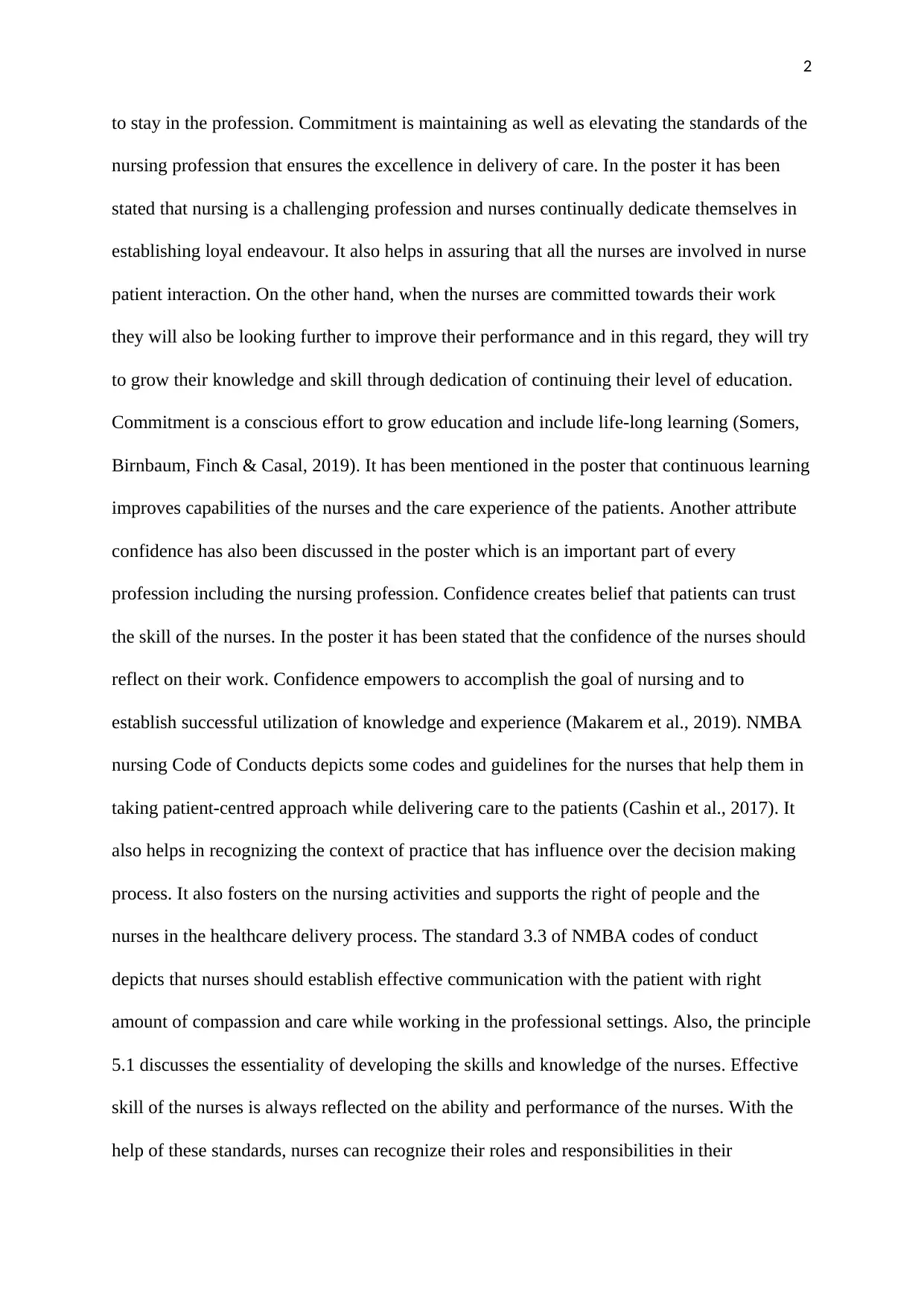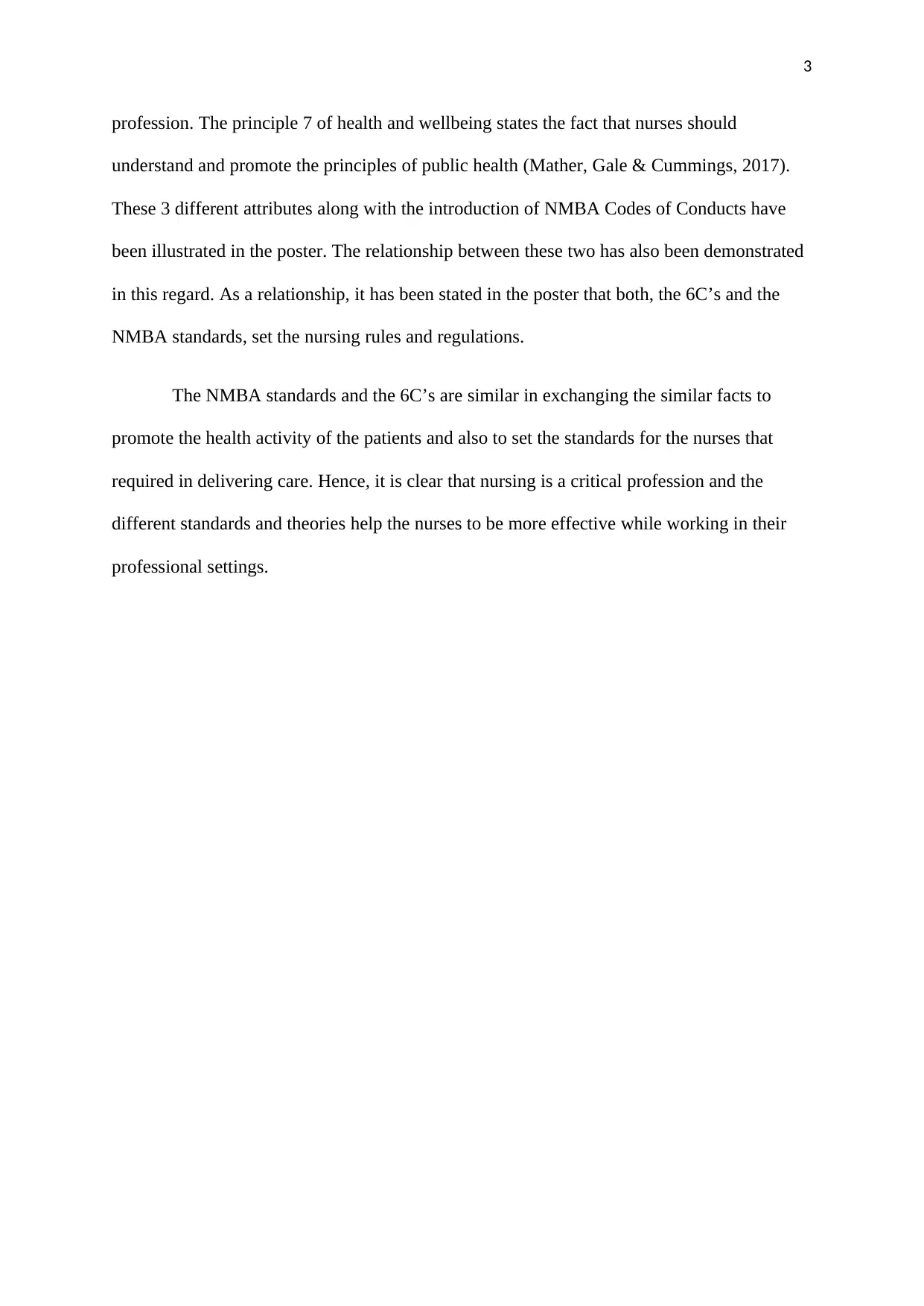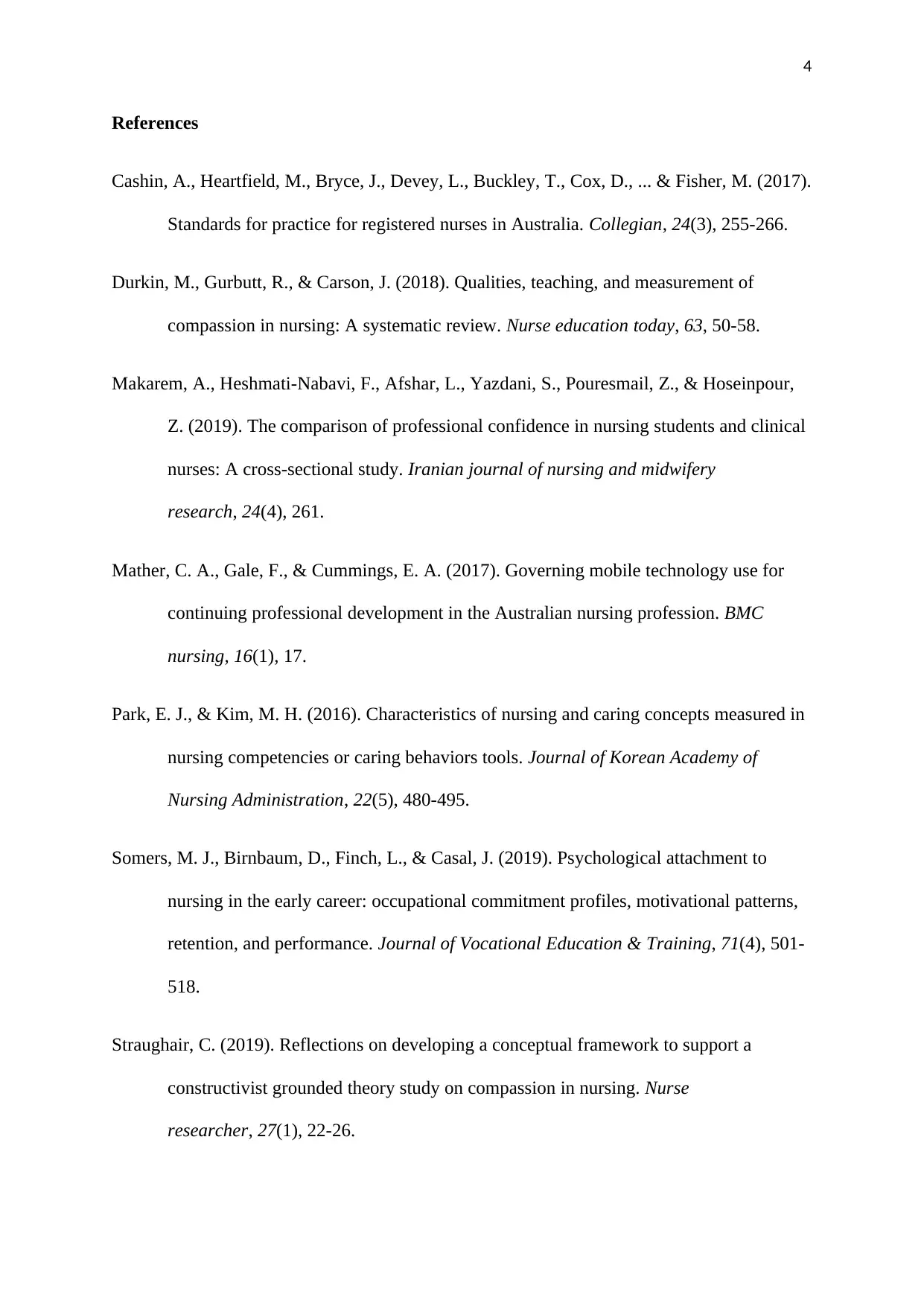The 6Cs of Caring and NMBA Code of Conduct: A Nursing Infographic
VerifiedAdded on 2022/09/22
|4
|1273
|20
Project
AI Summary
This assignment is an infographic and rationale that explores the application of Roach's 6Cs of Caring (Compassion, Competence, Conscience, Confidence, Commitment, and Comportment) in nursing practice, alongside the guidelines established by the Nursing and Midwifery Board of Australia (NMBA) Code of Conduct. The rationale provides a detailed explanation of each of Roach's 6Cs, emphasizing their significance in building nurse-patient relationships and ensuring quality care. It highlights the importance of compassion, commitment, and confidence, and how these attributes align with NMBA standards to promote safe and patient-centered care. The assignment also outlines the relationship between the 6Cs and NMBA standards in setting the rules and regulations for nurses. The poster format enables students to develop written and verbal communication skills, required for all nursing interactions, and an understanding of nursing models used to plan care and identify health priorities. The assignment demonstrates the critical role of various standards and theories in enhancing the effectiveness of nurses in their professional settings.

1
Rationale
The poster discusses Roach’s 6C’s of caring and NMBA Code of Conduct for nursing
and midwifery. Nursing is a complex profession and they deal with different patients with
different health conditions. According to Sister Simone Roach, caring is the human mode of
being. She also stated that caring is the underlying concept that demonstrate what a nurse do
each and every day. Simone Roach developed 6C’s of caring that are described as the
attributes of caring that helps in identifying some specific behaviour of nurses when they are
engaged in providing care to the patients (Park & Kim, 2016). The 6C’s are Compassion,
Competence, Conscience, Confidence, Commitment, and Comportment.
The first attribute compassion basically refers to a situation to be with the people
while they are suffering. This sensitivity and empathy to human pain allows one to
experience the suffering of others. According to Roach, compassion is an essential
component in nursing that requires while building nurse-patient relationship. A
compassionate nurse is always more empathetic to the pain and sufferings of his/her patients
which helps in establishing a friendly relationship between the nurse and the patient. Hence,
compassionate care is a fundamental aspect of nursing and on the other hand, patients also
expect compassionate care from the healthcare providers. Also according to researchers, the
link between compassion and nursing is not new and it is one of the greatest strengths of this
profession (Straughair, 2019). Some researchers also mentioned that with the inclusion of
compassion in the profession, a nurse can see a patient’s situation as more than a normal
medical scenario (Durkin, Gurbutt & Carson, 2018). In the info graphic poster, this attribute
by Roach has been discussed in short and also the significance of the attribute has been
clearly demonstrated in the poster. Roach identified that without compassion, nursing
profession is incomplete and patients are not satisfied with the care process. Another attribute
commitment has also been discussed in the poster. Roach defined commitment as the desire
Rationale
The poster discusses Roach’s 6C’s of caring and NMBA Code of Conduct for nursing
and midwifery. Nursing is a complex profession and they deal with different patients with
different health conditions. According to Sister Simone Roach, caring is the human mode of
being. She also stated that caring is the underlying concept that demonstrate what a nurse do
each and every day. Simone Roach developed 6C’s of caring that are described as the
attributes of caring that helps in identifying some specific behaviour of nurses when they are
engaged in providing care to the patients (Park & Kim, 2016). The 6C’s are Compassion,
Competence, Conscience, Confidence, Commitment, and Comportment.
The first attribute compassion basically refers to a situation to be with the people
while they are suffering. This sensitivity and empathy to human pain allows one to
experience the suffering of others. According to Roach, compassion is an essential
component in nursing that requires while building nurse-patient relationship. A
compassionate nurse is always more empathetic to the pain and sufferings of his/her patients
which helps in establishing a friendly relationship between the nurse and the patient. Hence,
compassionate care is a fundamental aspect of nursing and on the other hand, patients also
expect compassionate care from the healthcare providers. Also according to researchers, the
link between compassion and nursing is not new and it is one of the greatest strengths of this
profession (Straughair, 2019). Some researchers also mentioned that with the inclusion of
compassion in the profession, a nurse can see a patient’s situation as more than a normal
medical scenario (Durkin, Gurbutt & Carson, 2018). In the info graphic poster, this attribute
by Roach has been discussed in short and also the significance of the attribute has been
clearly demonstrated in the poster. Roach identified that without compassion, nursing
profession is incomplete and patients are not satisfied with the care process. Another attribute
commitment has also been discussed in the poster. Roach defined commitment as the desire
Paraphrase This Document
Need a fresh take? Get an instant paraphrase of this document with our AI Paraphraser

2
to stay in the profession. Commitment is maintaining as well as elevating the standards of the
nursing profession that ensures the excellence in delivery of care. In the poster it has been
stated that nursing is a challenging profession and nurses continually dedicate themselves in
establishing loyal endeavour. It also helps in assuring that all the nurses are involved in nurse
patient interaction. On the other hand, when the nurses are committed towards their work
they will also be looking further to improve their performance and in this regard, they will try
to grow their knowledge and skill through dedication of continuing their level of education.
Commitment is a conscious effort to grow education and include life-long learning (Somers,
Birnbaum, Finch & Casal, 2019). It has been mentioned in the poster that continuous learning
improves capabilities of the nurses and the care experience of the patients. Another attribute
confidence has also been discussed in the poster which is an important part of every
profession including the nursing profession. Confidence creates belief that patients can trust
the skill of the nurses. In the poster it has been stated that the confidence of the nurses should
reflect on their work. Confidence empowers to accomplish the goal of nursing and to
establish successful utilization of knowledge and experience (Makarem et al., 2019). NMBA
nursing Code of Conducts depicts some codes and guidelines for the nurses that help them in
taking patient-centred approach while delivering care to the patients (Cashin et al., 2017). It
also helps in recognizing the context of practice that has influence over the decision making
process. It also fosters on the nursing activities and supports the right of people and the
nurses in the healthcare delivery process. The standard 3.3 of NMBA codes of conduct
depicts that nurses should establish effective communication with the patient with right
amount of compassion and care while working in the professional settings. Also, the principle
5.1 discusses the essentiality of developing the skills and knowledge of the nurses. Effective
skill of the nurses is always reflected on the ability and performance of the nurses. With the
help of these standards, nurses can recognize their roles and responsibilities in their
to stay in the profession. Commitment is maintaining as well as elevating the standards of the
nursing profession that ensures the excellence in delivery of care. In the poster it has been
stated that nursing is a challenging profession and nurses continually dedicate themselves in
establishing loyal endeavour. It also helps in assuring that all the nurses are involved in nurse
patient interaction. On the other hand, when the nurses are committed towards their work
they will also be looking further to improve their performance and in this regard, they will try
to grow their knowledge and skill through dedication of continuing their level of education.
Commitment is a conscious effort to grow education and include life-long learning (Somers,
Birnbaum, Finch & Casal, 2019). It has been mentioned in the poster that continuous learning
improves capabilities of the nurses and the care experience of the patients. Another attribute
confidence has also been discussed in the poster which is an important part of every
profession including the nursing profession. Confidence creates belief that patients can trust
the skill of the nurses. In the poster it has been stated that the confidence of the nurses should
reflect on their work. Confidence empowers to accomplish the goal of nursing and to
establish successful utilization of knowledge and experience (Makarem et al., 2019). NMBA
nursing Code of Conducts depicts some codes and guidelines for the nurses that help them in
taking patient-centred approach while delivering care to the patients (Cashin et al., 2017). It
also helps in recognizing the context of practice that has influence over the decision making
process. It also fosters on the nursing activities and supports the right of people and the
nurses in the healthcare delivery process. The standard 3.3 of NMBA codes of conduct
depicts that nurses should establish effective communication with the patient with right
amount of compassion and care while working in the professional settings. Also, the principle
5.1 discusses the essentiality of developing the skills and knowledge of the nurses. Effective
skill of the nurses is always reflected on the ability and performance of the nurses. With the
help of these standards, nurses can recognize their roles and responsibilities in their

3
profession. The principle 7 of health and wellbeing states the fact that nurses should
understand and promote the principles of public health (Mather, Gale & Cummings, 2017).
These 3 different attributes along with the introduction of NMBA Codes of Conducts have
been illustrated in the poster. The relationship between these two has also been demonstrated
in this regard. As a relationship, it has been stated in the poster that both, the 6C’s and the
NMBA standards, set the nursing rules and regulations.
The NMBA standards and the 6C’s are similar in exchanging the similar facts to
promote the health activity of the patients and also to set the standards for the nurses that
required in delivering care. Hence, it is clear that nursing is a critical profession and the
different standards and theories help the nurses to be more effective while working in their
professional settings.
profession. The principle 7 of health and wellbeing states the fact that nurses should
understand and promote the principles of public health (Mather, Gale & Cummings, 2017).
These 3 different attributes along with the introduction of NMBA Codes of Conducts have
been illustrated in the poster. The relationship between these two has also been demonstrated
in this regard. As a relationship, it has been stated in the poster that both, the 6C’s and the
NMBA standards, set the nursing rules and regulations.
The NMBA standards and the 6C’s are similar in exchanging the similar facts to
promote the health activity of the patients and also to set the standards for the nurses that
required in delivering care. Hence, it is clear that nursing is a critical profession and the
different standards and theories help the nurses to be more effective while working in their
professional settings.
⊘ This is a preview!⊘
Do you want full access?
Subscribe today to unlock all pages.

Trusted by 1+ million students worldwide

4
References
Cashin, A., Heartfield, M., Bryce, J., Devey, L., Buckley, T., Cox, D., ... & Fisher, M. (2017).
Standards for practice for registered nurses in Australia. Collegian, 24(3), 255-266.
Durkin, M., Gurbutt, R., & Carson, J. (2018). Qualities, teaching, and measurement of
compassion in nursing: A systematic review. Nurse education today, 63, 50-58.
Makarem, A., Heshmati-Nabavi, F., Afshar, L., Yazdani, S., Pouresmail, Z., & Hoseinpour,
Z. (2019). The comparison of professional confidence in nursing students and clinical
nurses: A cross-sectional study. Iranian journal of nursing and midwifery
research, 24(4), 261.
Mather, C. A., Gale, F., & Cummings, E. A. (2017). Governing mobile technology use for
continuing professional development in the Australian nursing profession. BMC
nursing, 16(1), 17.
Park, E. J., & Kim, M. H. (2016). Characteristics of nursing and caring concepts measured in
nursing competencies or caring behaviors tools. Journal of Korean Academy of
Nursing Administration, 22(5), 480-495.
Somers, M. J., Birnbaum, D., Finch, L., & Casal, J. (2019). Psychological attachment to
nursing in the early career: occupational commitment profiles, motivational patterns,
retention, and performance. Journal of Vocational Education & Training, 71(4), 501-
518.
Straughair, C. (2019). Reflections on developing a conceptual framework to support a
constructivist grounded theory study on compassion in nursing. Nurse
researcher, 27(1), 22-26.
References
Cashin, A., Heartfield, M., Bryce, J., Devey, L., Buckley, T., Cox, D., ... & Fisher, M. (2017).
Standards for practice for registered nurses in Australia. Collegian, 24(3), 255-266.
Durkin, M., Gurbutt, R., & Carson, J. (2018). Qualities, teaching, and measurement of
compassion in nursing: A systematic review. Nurse education today, 63, 50-58.
Makarem, A., Heshmati-Nabavi, F., Afshar, L., Yazdani, S., Pouresmail, Z., & Hoseinpour,
Z. (2019). The comparison of professional confidence in nursing students and clinical
nurses: A cross-sectional study. Iranian journal of nursing and midwifery
research, 24(4), 261.
Mather, C. A., Gale, F., & Cummings, E. A. (2017). Governing mobile technology use for
continuing professional development in the Australian nursing profession. BMC
nursing, 16(1), 17.
Park, E. J., & Kim, M. H. (2016). Characteristics of nursing and caring concepts measured in
nursing competencies or caring behaviors tools. Journal of Korean Academy of
Nursing Administration, 22(5), 480-495.
Somers, M. J., Birnbaum, D., Finch, L., & Casal, J. (2019). Psychological attachment to
nursing in the early career: occupational commitment profiles, motivational patterns,
retention, and performance. Journal of Vocational Education & Training, 71(4), 501-
518.
Straughair, C. (2019). Reflections on developing a conceptual framework to support a
constructivist grounded theory study on compassion in nursing. Nurse
researcher, 27(1), 22-26.
1 out of 4
Related Documents
Your All-in-One AI-Powered Toolkit for Academic Success.
+13062052269
info@desklib.com
Available 24*7 on WhatsApp / Email
![[object Object]](/_next/static/media/star-bottom.7253800d.svg)
Unlock your academic potential
Copyright © 2020–2025 A2Z Services. All Rights Reserved. Developed and managed by ZUCOL.





